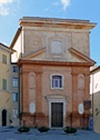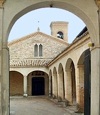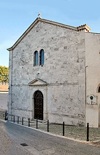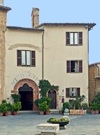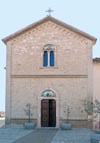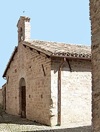Nunneries of Montefalco
This page describes three of the nunneries that were established in Montefalco:
-
✴the ex-nunnery of San Clemente;
-
✴the church and nunnery of San Leonardo; and
-
✴the ex-nunnery of Santa Maria Maddalena.
The important Augustinian nunnery of Santa Chiara has its own page - see below).
Palazzo Comunale (1270)
This was the site of the palace of the Counts of Antignano and Coccorone in the 12th century, which was destroyed, like much of the rest of the town, during its rebellion against the Emperor Frederick II in 1249. The building of the present palace marked the culmination of the recovery of Montefalco.
Patrician Palaces
The palaces described on this page are:
-
✴Palazzo Bontadosi (16th century), illustrated here;
-
✴Palazzo de Cuppis (rebuilt 1480-9);
-
✴Palazzo Santi Gentili (late 16th century);
-
✴Palazzi Senili (16th century)
-
•in Corso Goffredo Mameli; and
-
•in Piazza del Comune; and
-
✴Palazzi Tempestivi (16th century)
-
•in Piazzetta Mustafà; and
-
•in Via Tempestivi.
Sant' Agostino (1279-85)
The Augustines acquired the church of Santa Maria de Plateola, outside Portone di Santa Maria,in 1257
, which promoted the settlement of what became known as Borgo del Castellare.
In 1275, the Commune gave them the nearby church of San Giovanni Battista, which they demolished to build the present church. They abandoned the church and convent in 1978. The church, which now serves a parish, has been recently restored. It contains a number of interesting frescoes.
San Bartolomeo (11th century)
This church became one of the most important in 1222-36, when it was at the heart of a policy of encouraging the population of the area to concentrate within the walls of town. It acquired all of the privileges of the former parish church of
San Fortunato in the late 14th century, was raised to the rank of collegiate church in 1599. It also acquired the church of
Sant’ Illuminata when the Augustinian community there was suppressed in 1653. It was restored and enlarged in 1638-46: the apse of the original church survived this restoration, and other elements from the original structure, [including the original recessed portal], are embedded in the facade.
Santa Chiara da Montefalco (1615-70)
St Clare and her sisters moved here in 1281, and she was the Abbess in 1291 until he death in 1303.
Bishop Maffeo Barberini of Spoleto (the future Pope Urban VIII) commissioned the design of the present church in 1615, probably from the Perugian architect, Valentino Martelli. An earlier church (1430) now forms the right transept and houses the relics of St Clare. The apse of the original church, which contains important frescoes (1333) in now a chapel in the nunnery (available to visitors).
San Filippo Neri (1705)
A congregation of Oratorian Fathers, which moved to Montefalco in 1697, built this church in Piazza del Comune in 1705. It was deconsecrated in 1860.
San Fortunato (1442)
St Severus built the first church here on the site of the burial of St Fortunatus, according to tradition in 422. The Lombard Dukes of Spoleto fostered the cult and had a fortress nearby. San Fortunato became an important parish church under the jurisdiction of the
Abbazia di Sassovivo in the 11th century. In the 1320-55, when Montefalco became the administrative centre of the Duchy of Spoleto, San Fortunato became the curial church. It declined in the late 14th century and its privileges passed
San Bartolomeo. In 1446, the site passed to the Observant Franciscans, who rebuilt the church and built the adjacent convent. The complex contains important frescoes by Benozzo Gozzoli and Tiberio d’ Assisi.
San Francesco (1336-40)
The Franciscans were documented at Santa Maria della Selvetta (now San Rocco, below) in 1242 and built a new church outside Porta San Clemente in 1275-1306. The insecurity of this site became apparent in 1335, during the Ghibelline revolt, and they subsequently built the present church inside the walls. The complex passed to the Commune in 1863, and it now houses the Pinacoteca and the Museo Civico (in the old wine cellar). It still contains a number of its original frescoes, including those by Benozzo Gozzoli and Perugino.
Sant' Illuminata (1491- 1500)
St Clare of Montefalco joined the nunnery here in 1274, when she was only six years old. She and many of the other nuns moved to Santa Croce (now Santa Chiara da Montefalco, above) in 1281. The sisters that remained behind built the first church here in 1304, but it was closed in 1480, when they too moved to Santa Croce. Anselmo da Montefalco, general of the Augustinian Order, acquired the site in 1491 and transferred it to a community of Augustinian friars who rebuilt the church. The community was suppressed in 1653, and the church was passed to the Collegiata di San Bartolomeo. It still contains a number of frescoes by (or attributed to) Francesco Melanzio.
Santa Maria della Consolazione (1588)
A fresco (1577) of the Madonna and Child with SS Francis and Valentine in an aedicule on this site became highly venerated in 1584, when it apparently cured a crippled man. This led to the construction of the basilica which now houses it.
Santa Maria di Piazza (16th century)
The Confraternita del Sacramento built this church on the site of an earlier one that was documented as Santa Maria de Platea in the early 13th century. This earlier church had been used for the meetings of the Commune in its early years. The present church contains important frescoes (1517) by Francesco Melanzio.
Santa Maria della Selvetta, later San Rocco (13th century)
This was the first church of the Franciscans of Montefalco. They moved nearer to Montefalco ca. 1275 and the site subsequently passed to a community of Fraticelli. When the Fraticelli were formally constituted as the Third Order Regular of St Francis in 147, this became the site of their early General Chapters. The dedication of the church was changed to San Rocco in 1516. The Fraticelli left in 1526 and the church passed to the diocese of Spoleto. A community of Poor Clares moved here in 1536 but they moved again in 1577, at which point San Rocco was abandoned. It was partly restored in 1947.
Santa Maria di Turrita (12th century)
St Fortunatus was the priest of the churches of Turrita, which probably included a church on this site. The present church was first documented in 1161, and another document from 1216 refers to a programme of re-modelling. The adjoining monastery was governed by a prior appointed by the Abbey of Santo Stefano di Manciano di Trevi. In 1296, Bishop Gerardo Pigolotti of Spoleto suppressed and demolished the monastery, which was in decline, and transferred the church to the Cathedral Chapter of Spoleto.
Other Churches
This page describes four of the original five parish churches of Montefalco:
-
✴Santa Maria del Popolo (demolished);
-
✴San Giovanni di Colle Mora (demolished);
-
✴San Lorenzo (12th century), which was re-dedicated as Santa Maria delle Grazie in 1769, when an image in the church of the Madonna delle Grazie performed a miracle; and
-
✴Santa Maria di Turri (demolished).
The fifth of the original parish churches, San Bartolomeo, has its own page (above).
This page also describes three other small churches:
-
✴Santa Elisabetta di Vecciano (17th century), which was built to house an aedicule that contains a venerated image of the Madonna and Child;
-
✴Santa Lucia (12th century), illustrated here; and
-
✴Santa Maria dei Laici (17th century)
Walls of Montefalco
The first walls of Montefalco were probably built in the 12th century and were first documented in 1216. A second circuit, which was built in the 13th century, was probably badly damaged when soldiers of the Emperor Frederick II sacked Montefalco in 1249. Walls were built in the 14th century to enclose two suburbs:
-
✴Borgo del Castellare (shown in this fresco detail); and
-
✴Borgo di Colle Mora.










